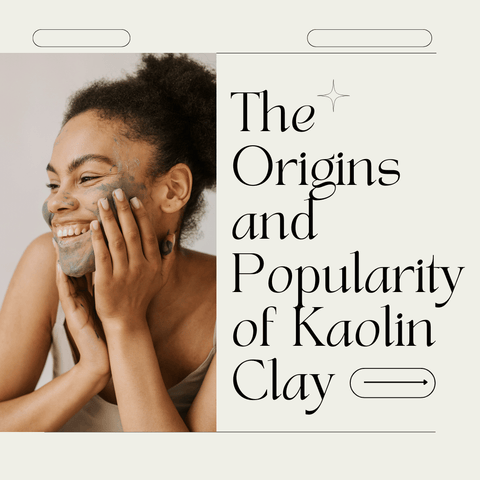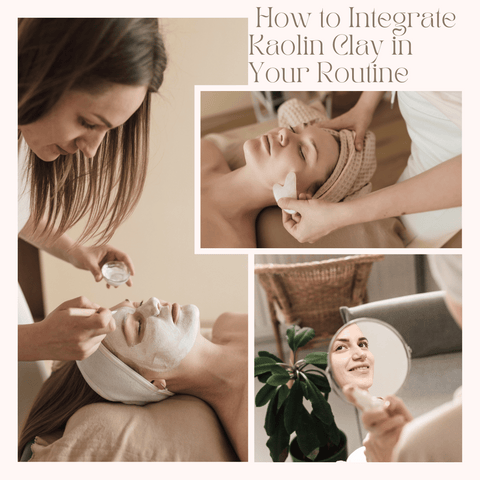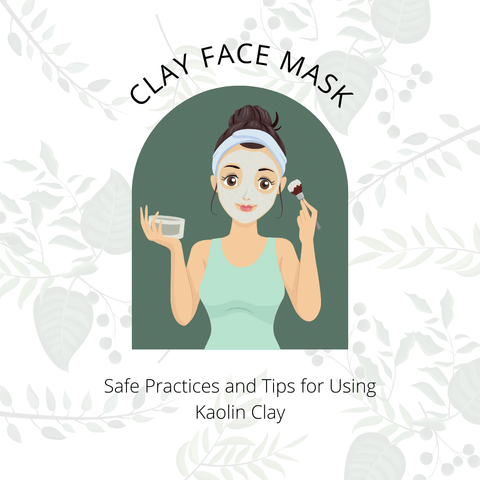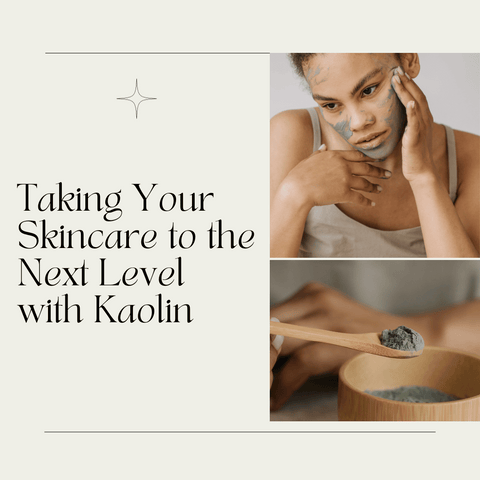Kaolin clay, often known as white clay or China clay, is a versatile and naturally occurring material with several properties and applications. The origin and composition of kaolin clay, color and texture, absorbent properties, gentle exfoliation, calming and soothing, detoxifying, oil control, mild cleansing, cosmetic and skincare applications, pharmaceutical and industrial uses, historical and cultural significance, sustainability, and eco-friendliness will all be discussed. It is a crucial component for building healthy and radiant skin due to its delicate yet powerful characteristics.
The Origins and Popularity of Kaolin Clay

Kaolin clay's origins and appeal may be traced back to its long history and diverse variety of applications. Here's a closer look at how kaolin clay grew and acquired appeal over time, including its origins, popularity, historical relevance, and present popularity. Its use has expanded over time, with uses spanning from pottery and ceramics to skincare, cosmetics, pharmaceuticals, and a variety of industries. Its long-lasting appeal stems from its natural and effective characteristics, which meet a wide spectrum of current beauty and skincare requirements.
What is Kaolin Clay?
Kaolin clay, often known as kaolin or white clay, is a naturally occurring mineral substance with numerous applications in a variety of industries. It is named after the Kaoling hill in China, where the clay was discovered and used for the first time. It is a popular choice in beauty and health products due to its ability to address a wide range of skin conditions while still being acceptable for sensitive skin.
Why has Kaolin gained prominence in skincare?
For a variety of compelling reasons, kaolin clay has acquired prominence in skincare, making it a highly sought-after ingredient in a wide range of skincare products. Gentle exfoliation, absorbent characteristics, relaxing and calming, detoxifying, suited for all skin types, increased texture, non-comedogenic, versatile formulation, clean beauty trend, safety, and minimal allergenicity are the primary aspects leading to its success in the skincare market. Because of its capacity to address common skincare conditions while also providing a relaxing and tranquil sensation, it has become a popular ingredient among consumers and skincare enthusiasts.
Dive Deep into the Benefits

Exploring the benefits of kaolin clay reveals a plethora of benefits for skin health and beauty. The following are the primary advantages of using kaolin clay in skincare:
-
Gentle Exfoliation: Kaolin clay exfoliates the skin gently by removing dead skin cells and impurities from the surface. This helps to improve skin texture and promote a smoother, brighter complexion.
-
Oil Control: It is extremely effective at absorbing excess oils and sebum from the skin. This makes it especially useful for people with oily or combination skin, as it helps to reduce shine and the risk of clogged pores.
-
Acne Treatment: Because of its oil-absorbing and detoxifying properties, kaolin clay is beneficial for acne-prone skin. It can help unclog pores, reduce the appearance of blackheads, and reduce breakouts.
-
Soothing and calming: Kaolin clay has natural soothing and anti-inflammatory properties that can relieve redness, irritation, and inflammation. It is suitable for sensitive or irritated skin and can help with a variety of skin conditions.
-
Detoxification: Kaolin clay attracts impurities, pollutants, and toxins that are present on the skin's surface. It helps to purify the skin by drawing out impurities, leaving it looking younger and healthier.
-
Improved Skin Tone: Using kaolin clay on a regular basis can help improve overall skin tone and complexion. It has the ability to even out skin tone and reduce the appearance of uneven pigmentation.
-
Hydration: In addition to absorbing excess oils, kaolin clay aids in the maintenance of the skin's natural moisture balance. It is suitable for combination skin types because it does not dry the skin.
-
Non-Comedogenic: Kaolin clay is non-comedogenic, which means it does not clog pores. This makes it a safe option for skincare products because it does not contribute to the formation of acne or comedones.
-
Versatile Formulation: Kaolin clay is used in skincare products that come in a variety of shapes, including masks, cleansers, scrubs, and powders. This enables people to select products that suit their skincare preferences and routines.
-
Sustainable and environmentally friendly: Kaolin clay is a natural and environmentally friendly ingredient. It is typically mined from the earth and can be obtained in a sustainable manner.
-
Skin Sensory Experience: Kaolin clay enhances skincare routines with a luxurious sensory experience. Its smooth texture and cooling sensation when applied to the skin improve the overall skincare experience.
-
Clean Beauty: Because it is a natural ingredient with minimal processing, kaolin clay fits the clean beauty trend. It is frequently used in clean, environmentally friendly skincare formulations.
Radiant and Glowing Skin Unveiled
When added to your skincare routine, kaolin clay can help you achieve vibrant and luminous skin. Exfoliation, oil absorption, detoxification, skin tone improvement, soothing and calming, moisture balance, preparing skin for other products, clear pores, improved texture, and sensory experience are just a few examples. Consider introducing kaolin clay-based products into your skincare regimen to reveal vibrant and glowing skin. Kaolin clay masks, cleansers, and exfoliating scrubs are examples of such products. To attain the greatest results, stick to your skincare routine and use products that are appropriate for your skin type and issues. Furthermore, a healthy lifestyle that includes proper hydration, a balanced diet, and sun protection can improve the shine of your skin.
Deep Cleansing without Stripping
Kaolin clay is an excellent ingredient for deep cleansing the skin while preserving its natural oils. Here's how to cleanse thoroughly with kaolin clay while keeping your skin hydrated:
-
Choose the Best Kaolin Clay Product: Look for cleansers or masks that contain kaolin clay as a primary ingredient. These products are designed specifically for deep cleansing.
-
Prepare Your Skin: To begin, wet your face with lukewarm water. This helps to open the pores and prepares the skin for cleansing.
-
Apply the Kaolin Clay Product: Follow the application guidelines provided with the product. In most cases, you will apply the kaolin clay product evenly to your face, avoiding the eye area.
-
Massage gently: Gently massage the product into your skin with your fingertips. This massaging action aids in the absorption of excess oil, dirt, and impurities from your pores by the kaolin clay.
-
Allow it to Dry: Follow the product's instructions and leave the product on your skin for the recommended amount of time. Kaolin clay dries in about 10-15 minutes.
-
Thoroughly rinse: After the clay has dried, rinse it with lukewarm water. Use gentle circular motions to help remove the clay from your skin.
-
Pat Dry: Using a clean, soft towel, gently pat your face dry. Rubbing is harmful to the skin and should be avoided.
-
Hydration: After cleansing, apply a hydrating serum, toner, or moisturiser to lock in moisture and keep your skin hydrated.
-
Frequency: How often you use a kaolin clay product depends on your skin type. Oily skin types may benefit from using it 2-3 times per week, while dry or sensitive skin types may find that once per week is sufficient. Adjust the frequency based on how your skin reacts.
-
Apply Sunscreen After Cleaning: Always apply sunscreen after cleansing, especially if you are using kaolin clay during the day. Clay masks can increase your skin's susceptibility to UV damage.
The Mineral Boost: Essential for Healthy Skin
Minerals are necessary for maintaining healthy skin because they play a variety of important roles in skin function and overall health. Here's how minerals help skin health and why they're referred to as a mineral boost for your skin:
-
Collagen Production: Minerals such as copper and zinc are necessary for collagen production, which is necessary for skin elasticity and firmness. Collagen provides structural support to the skin, allowing it to look youthful and smooth.
-
Cell Renewal: Minerals such as magnesium play a role in cell renewal. This ensures that old skin cells are shed and replaced with new ones, resulting in a youthful and radiant complexion.
-
Hydration: Sodium and potassium are electrolyte minerals that help maintain skin hydration by regulating water balance within skin cells. Proper hydration is essential for avoiding dry skin and maintaining a healthy skin barrier.
-
Antioxidant Defence: Selenium and zinc are antioxidants that help protect the skin from free radical oxidative stress. These minerals reduce the risk of premature aging and skin damage by neutralising free radicals.
-
Wound Healing: Minerals such as zinc are necessary for wound healing. They promote the regeneration of healthy skin cells, which aids in tissue repair and can help prevent scarring.
-
Skin Barrier Function: Calcium aids in the maintenance of the skin barrier's integrity. A healthy skin barrier is necessary for protecting against external irritants and keeping moisture levels stable.
-
Oil Balance: Zinc regulates oil production in the skin, making it beneficial for people with oily or acne-prone skin. It helps to control excess sebum, lowering the likelihood of clogged pores and breakouts.
-
Anti-Inflammatory Effects: Minerals such as magnesium and selenium are anti-inflammatory. They can help to soothe irritated or inflamed skin conditions like acne and rosacea.
-
UV Protection: Physical sunscreens contain minerals such as zinc oxide and titanium dioxide that provide broad-spectrum UV protection. They form a protective barrier on the skin's surface to shield it from harmful UV rays.
-
Detoxification: Minerals such as sulphur help the body's natural detoxification processes by removing toxins that can harm skin health.
To keep your skin healthy, make sure you are getting an adequate amount of essential minerals through your diet or, if necessary, supplements. Furthermore, topical skincare products containing mineral-rich ingredients, such as kaolin clay (rich in various minerals), can provide direct benefits to the skin by balancing oil production, detoxifying, and gently exfoliating.
The Magic Touch for Oily and Acne-prone Skin
Kaolin clay can be the magic touch for those with oily and acne-prone skin due to its unique properties that help control excess oil, minimise breakouts, and promote a clearer complexion. Here's how kaolin clay can benefit oily and acne-prone skin:
-
Oil Absorption: Kaolin clay is highly absorbent and effectively absorbs excess sebum (oil) from the skin's surface. This helps reduce shine and keeps the skin looking matte throughout the day.
-
Unclogs Pores: Excess oil production can lead to clogged pores and the formation of blackheads and whiteheads. Kaolin clay helps to unclog pores by removing the buildup of oil and dead skin cells.
-
Prevents Breakouts: By keeping pores clean and minimising oiliness, kaolin clay can reduce the likelihood of acne breakouts. It helps prevent the conditions that often lead to acne development.
-
Anti-Inflammatory: Kaolin clay has natural anti-inflammatory properties, which can help calm and soothe irritated or inflamed skin. This is especially beneficial for those with acne, as it can reduce redness and discomfort.
-
Gentle Exfoliation: Kaolin clay provides gentle exfoliation by removing dead skin cells, which can contribute to acne. This encourages skin cell turnover and helps prevent pore blockages.
-
Detoxification: Kaolin clay acts as a magnet for impurities and toxins on the skin's surface. Drawing out these impurities detoxifies the skin and promotes a healthier complexion.
-
Balances Skin: While it effectively reduces excess oil, kaolin clay does not overly dry out the skin. It helps maintain a balanced moisture level, preventing the skin from producing even more oil to compensate.
-
Minimises Scarring: Kaolin clay can assist in the healing process of acne lesions. By promoting the regeneration of healthy skin cells, it can minimise scarring and post-acne marks.
How to Integrate Kaolin Clay in Your Routine

Depending on your skin type and problems, incorporating kaolin clay into your skincare routine can bring a range of benefits. Determine your skin type and concerns, choose the right kaolin clay product, frequency of use, patch test, cleansing, mask application, spot treatment (optional), hydration, sun protection, monitor your skin, consistency is key, and adjust as needed are all steps in effectively incorporating kaolin clay into your routine. Keep in mind that skincare is highly individual, and what works for one person may not work for another. If you have any underlying skin disorders or questions about your skincare routine, it's critical to personalise your approach to your individual skin type and needs.
Choosing the Right Kaolin-based Products
Choosing the best kaolin-based products for your skincare routine necessitates taking into account your skin type, issues, and product preferences. Here's a guide to help you choose the best kaolin clay products for your needs, including identifying your skin type, determining your skin concerns, the different types of kaolin clay products, the ingredients list, skin sensitivity, packaging and shelf life, reviews and recommendations, patch tests, sunscreen considerations, budget, and brand reputation. You can make an informed choice that meets your skincare goals by examining criteria such as skin type, concerns, ingredients, and reviews. If you have specific skin concerns or questions about product selection, it's also a good idea to contact with a dermatologist or skincare specialist for personalised advice.
Masks and Treatments: Getting the Most Out of Kaolin
To get the most out of kaolin clay masks and treatments, you must use them appropriately and successfully incorporate them into your skincare routine. Here are some pointers on how to get the most out of kaolin clay masks and treatments:
-
Start with Clean Skin: Make sure your face is clean and clear of makeup, sunscreen, and other products before using a kaolin clay mask or treatment. Gently cleanse and pat dry your skin with a light cleanser.
-
Perform a Patch Test: Perform a patch test on a small area of your skin before using a new kaolin clay product, especially if you have sensitive skin, to check for any unpleasant reactions or allergies.
-
Choose the Right Kaolin Clay Product: Choose a kaolin clay mask or treatment that addresses your skin's specific concerns. Additional substances may be included in different formulations to address concerns such as acne, dullness, or sensitivity.
-
Apply Evenly: Apply the kaolin clay product on your face evenly, avoiding the sensitive eye and lip areas. Check for any thick or uneven coatings that may take longer to dry.
-
Follow Product Instructions: For recommended usage times, read and follow the product's instructions. Kaolin clay masks normally dry in 10-15 minutes, but this can vary depending on the product.
-
Relax While Masking: Take some time to unwind while your mask is curing. To improve the calming and self-care aspects of your skincare routine, lie down, close your eyes, and practise deep breathing.
-
Avoid Over-drying: Do not leave the kaolin clay mask on for any longer than necessary. Over-drying the skin can result in severe dryness and irritation.
-
Rinse Thoroughly: Rinse the mask off with lukewarm water. To help loosen the clay and properly remove it from your skin, use gentle circular motions. Using a clean, soft cloth, pat your face dry.
-
Hydrate Afterward: Follow up with a moisturising moisturiser after using a kaolin clay mask or treatment to lock in moisture and preserve skin balance. This step is critical, especially if you have dry or sensitive skin.
-
Sun Protection: Apply sunscreen to protect your skin from UV damage if you use kaolin clay products during the day, as some exfoliation may have occurred during the treatment.
-
Frequency of Use: Based on your skin type and concerns, determine how frequently you should use kaolin clay masks or treatments. Typically, 1-2 times per week is sufficient, but adjust according to your skin's response.
-
Be Patient: Consistency is key when using skincare treatments. Allow your skin to adjust, and you will notice improvements in texture, oil control, and overall complexion.
-
Keep an eye on your skin: Keep an eye on how your skin reacts to kaolin clay. If you have any adverse reactions or persistent irritation, stop using the product and consult a dermatologist.
By carefully incorporating kaolin clay masks and treatments into your skincare routine, you can reap the full benefits of this versatile ingredient, which include oil control, detoxification, exfoliation, and a brighter complexion.
Safe Practices and Tips for Using Kaolin Clay

Including kaolin clay in your skincare routine can provide several benefits, but it's critical to use it safely to ensure a great experience. Here are some safety precautions to take when working with kaolin clay:
-
Patch Test: Perform a patch test before using a new kaolin clay product, especially if you have sensitive skin. Apply a small amount of the product to a hidden part of your skin (e.g., behind the ear or on the inner forearm) and wait 24-48 hours to see if there are any negative responses or allergies.
-
Cleanse Your Skin: Always start with clean, dry skin before applying a kaolin clay product. Gently cleanse your face to remove makeup, dirt, and impurities.
-
Choose the Right Product: Select a kaolin clay product that is suitable for your skin type and concerns. Different formulas may meet certain needs, such as oily skin, acne-prone skin, or sensitive skin.
-
Follow Instructions: Read and carefully read the product's directions. This includes the suggested usage time, frequency, and any extra processes.
-
Apply Evenly: When using a kaolin clay mask or treatment, make sure to distribute it evenly around your face, avoiding the eye and lip areas. A consistent application aids the product's effectiveness.
-
Do Not Over-Exfoliate: Excessive use of kaolin clay masks or treatments can result in over-exfoliation. One to two times each week is usually plenty. Excessive exfoliation might result in dryness, inflammation, and sensitivity.
-
Avoid Sensitive Areas: Avoid contact with sensitive areas such as the eyes and lips. Applying kaolin clay directly to these regions is not recommended since it can be excessively abrasive.
-
Do Not Let It Dry Completely: Do not leave a kaolin clay mask on your face until it dries and splits. It's time to rinse it off when it starts to feel slightly tight. Allowing it to dry completely can result in extreme dryness.
-
Use Lukewarm Water for Removal: Use lukewarm water to rinse kaolin clay goods. To help loosen the clay and guarantee full removal, use gentle circular strokes.
-
Pat Dry Gently: After rinsing, pat your face dry with a clean, soft towel. Rubbing is harmful to the skin and should be avoided.
-
Hydration: Apply a moisturiser immediately after using a kaolin clay product to replenish the skin's moisture barrier.
-
Sun Protection: Use sunscreen after using kaolin clay products during the day to protect your skin from UV damage, as some exfoliation may have occurred during the treatment.
-
Keep an eye on your skin: Keep an eye on how your skin reacts after applying kaolin clay. If you have any negative reactions, such as redness, itching, or increased irritation, stop using the product and consult a dermatologist.
-
Proper Storage: Keep your kaolin clay products in a cool, dry place away from direct sunlight. Proper storage aids in the preservation of their efficacy and shelf life.
By following these safe practises and tips, you can enjoy the benefits of kaolin clay while minimising the risk of adverse reactions or skin sensitivities. Keep in mind that skincare is highly individual, so it's important to listen to your skin and adjust your routine accordingly.
Understanding Your Skin's Needs
Understanding your skin's demands is an important step in creating an effective skincare programme that tackles your individual difficulties while also maintaining skin health. Identify your skin type, recognise your skin concerns, conduct a self-assessment, consider external factors, consult a dermatologist, do patch testing, adapt your routine, be consistent, adjust as needed, listen to your skin, use sun protection, stay hydrated, and maintain a healthy lifestyle are all ways to assess your skin and determine its unique needs. Regular evaluation, flexibility, and sensitivity to the signals of your skin can help you obtain the finest results over time.
Optimizing Frequency and Application
To achieve the best effects while avoiding overuse or skin irritation, optimise the frequency and application of your skincare programme. Cleaning, exfoliation, toning, treatment serums, moisturising, sunscreen, specialist products (e.g., masks), eye cream, adapting to your skin's demands, and patience are some broad principles to help you optimise your skincare regimen. Keep an eye on how your skin reacts to each product and make adjustments as appropriate. If you have specific skin disorders or concerns, seek personalised advice and product suggestions from a dermatologist or skincare professional.
Taking Your Skincare to the Next Level with Kaolin

Kaolin clay can be an excellent addition to your skincare routine, taking it to the next level by providing numerous advantages for a variety of skin types and issues. Here's how to use it in your skincare routine, getting the most out of it: deep cleansing and detoxification, oil control, gentle exfoliation, balancing combination skin, soothing and calming, targeted spot treatment, customise with other ingredients, using it as a makeup primer, and incorporating it into a multi-masking routine. Be patient and keep an eye on how your skin reacts to kaolin clay to adapt your routine for the best results. By carefully introducing kaolin clay into your skincare routine, you can enjoy enhanced skin texture, less oiliness, and a more radiant complexion.









































